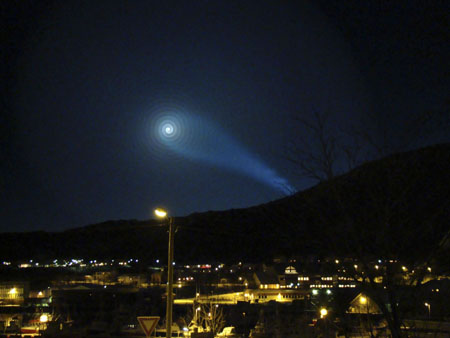Global General
New Russian missile flop sparks UFO frenzy
(Agencies)
Updated: 2009-12-11 10:13
|
 An unusual light phenomenon above the Norwegian city of Skjeroy.?[Agencies] |
Russia's defense ministry said a Bulava missile was launched Wednesday by a nuclear submarine submerged in the White Sea and its third stage suffered an unspecified failure.
Photographs and amateur video footage of the bluish-white in the Norwegian skies have been circulating on the Internet since Wednesday and spawning speculation of UFOs. The ministry did not confirm the lights were the result of the failed launch but military analysts said they clearly came from the Bulava explosion.
The botched launch was the twelfth test of the Bulava and its eighth failure, which deals another blow to Kremlin's hopes that the sea-based weapon would become a cornerstone of its nuclear arsenal.
"They will have to spend quite a long time trying to make it work," said Alexander Konovalov, the head of the Moscow-based Institute of Strategic Assessment, who agreed with Felgenhauer on the source of the lights over Norway.
"That is fraught with very negative consequences, up to the loss of the sea-based component of the Russian nuclear forces," he said.
The ministry said that a government commission was looking into the possible reasons behind the test failure.
Officials have insisted the Bulava's design is fine and have blamed the previous failures on manufacturing flaws resulting from post-Soviet industrial degradation. They have said it's difficult to control the quality of all the parts supplied by hundreds of subcontractors involved in the program.
"Every time they give a different reason for the failure, and that shows that there are problems with the quality of components," said Alexander Golts, an independent military analyst. "To build a state-of-the-art weapon like the Bulava, it's necessary to have a chain of subcontractors working well. Clearly, they can't do it."
Despite the repeated failures, the military must make Bulava work because Russia has already invested huge funds in building the new submarines supposed to carry it, military analysts said.
The first in a series of the new Borei-class nuclear submarines has already been launched and has been undergoing sea trials. Another two such subs, each capable of carrying 12 Bulava missiles, are being built and the construction of the fourth is to start soon.
The new submarines are supposed to replace the aging Soviet-era ones, which are approaching the end of their lifetime. The old submarines carry the Sineva missile, which are too big and too heavy for the new type of submarines.











